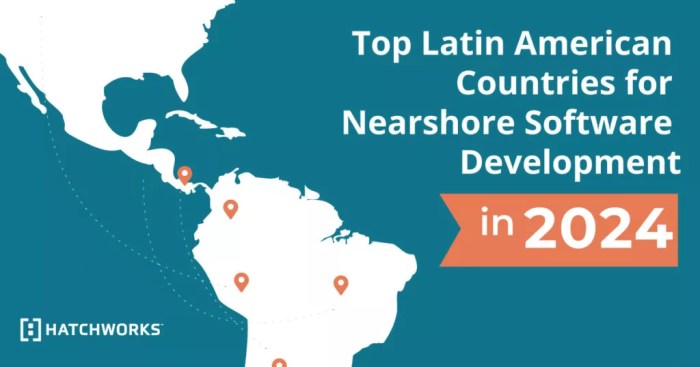Software development latin america – Latin America is experiencing a significant surge in its software development sector, transforming from a region primarily known for outsourcing to a vibrant hub for innovation and technological advancement. This growth is driven by a confluence of factors, including a burgeoning talent pool, increasing investment, and a growing demand for digital solutions across various industries. This article delves into the intricacies of the Latin American software development landscape, exploring its strengths, challenges, and future prospects.
The Rise of Latin American Software Developers
Latin America boasts a large and rapidly growing pool of skilled software developers. Countries like Brazil, Argentina, Mexico, Colombia, and Chile have established themselves as significant players in the global tech scene. This talent pool is fueled by robust educational institutions offering strong computer science and engineering programs, producing graduates with expertise in various programming languages and technologies.

Source: developerweek.com
Furthermore, a thriving culture of self-learning and online courses contributes to the continuous upskilling of developers, keeping them abreast of the latest trends and technologies.
Key Strengths of Latin American Developers:
- Strong technical skills: Latin American developers are known for their proficiency in various programming languages, including Java, Python, JavaScript, and C++.
- Cost-effectiveness: Compared to developers in North America or Europe, Latin American developers often offer competitive pricing, making them an attractive option for businesses seeking to optimize their development budgets. This relates directly to outsourcing software development in Latin America.
- Bilingual capabilities: Many Latin American developers possess strong English language skills, facilitating seamless communication with international clients.
- Cultural adaptability: Developers often demonstrate a high level of adaptability and understanding of diverse cultural contexts, which is crucial for successful collaboration in global projects.
- Growing Startup Ecosystem: The region is seeing a rise in tech startups, fostering innovation and creating opportunities for developers to work on cutting-edge projects.
Technological Landscape and Specializations: Software Development Latin America
The technological landscape in Latin America is diverse and rapidly evolving. While traditional software development methodologies remain prevalent, there’s a growing adoption of agile methodologies and DevOps practices. Specific areas of specialization are emerging, with significant growth observed in:
Emerging Tech Specializations:, Software development latin america
- Fintech: The fintech sector is booming, with numerous startups and established financial institutions investing heavily in software development for innovative financial solutions.
- E-commerce: The rapid growth of e-commerce in Latin America is driving demand for developers skilled in building and maintaining online stores and related applications.
- Artificial Intelligence (AI) and Machine Learning (ML): The adoption of AI and ML is accelerating, creating opportunities for developers specializing in these fields.
- Blockchain Technology: Interest in blockchain technology is growing, with developers exploring its applications in various sectors, including finance, supply chain management, and healthcare.
- Cybersecurity: With increasing cyber threats, the demand for cybersecurity professionals and developers is also on the rise.
Challenges and Opportunities
Despite the significant progress, the Latin American software development sector faces several challenges:
Challenges Facing the Industry:
- Digital Divide: Unequal access to technology and internet connectivity across the region remains a significant hurdle.
- Infrastructure Gaps: In some areas, the lack of robust digital infrastructure can hinder development and deployment.
- Brain Drain: The allure of higher salaries and better opportunities in other countries can lead to skilled developers migrating elsewhere.
- Bureaucracy and Regulations: Navigating bureaucratic processes and regulations can sometimes be challenging for businesses.
However, these challenges also present opportunities. Addressing the digital divide, investing in infrastructure, and creating a more supportive ecosystem for developers can unlock the region’s full potential. Government initiatives promoting digital literacy and attracting foreign investment are crucial in this regard. Furthermore, fostering collaboration between universities, businesses, and government agencies can create a robust and sustainable software development ecosystem.
Investment and Growth
Foreign direct investment (FDI) in Latin America’s tech sector is steadily increasing, further fueling the growth of the software development industry. Venture capital firms and multinational corporations are recognizing the region’s potential and investing in promising startups and established companies. This investment is not only creating jobs but also fostering innovation and driving technological advancement.
The Future of Software Development in Latin America
The future of software development in Latin America looks bright. With a growing talent pool, increasing investment, and a supportive ecosystem, the region is poised to become a major player in the global tech landscape. Continued focus on education, infrastructure development, and policy reforms will be crucial in ensuring sustained growth and competitiveness.
Frequently Asked Questions (FAQ)
- Q: What are the most popular programming languages used in Latin America?
A: Java, Python, JavaScript, C++, and PHP are among the most widely used programming languages. - Q: Is it cheaper to outsource software development to Latin America?
A: Generally, yes. Labor costs are often lower compared to North America or Europe. - Q: What are the major tech hubs in Latin America?
A: São Paulo (Brazil), Buenos Aires (Argentina), Mexico City (Mexico), Bogotá (Colombia), and Santiago (Chile) are prominent tech hubs. - Q: What are the biggest challenges facing the Latin American software development industry?
A: The digital divide, infrastructure gaps, brain drain, and bureaucratic hurdles are significant challenges. - Q: What are the future prospects for software development in Latin America?
A: The future looks promising, with continued growth driven by a skilled workforce, increasing investment, and a thriving startup ecosystem.
Call to Action
Are you looking to expand your business into Latin America or leverage the region’s talented software developers? Contact us today to learn more about how we can help you connect with top-tier developers and build cutting-edge software solutions.
Top FAQs
What are the most popular programming languages used in Latin America?

Source: hatchworks.com
While usage varies by country, popular languages include Java, Python, JavaScript, and C#.
What are the biggest challenges facing software developers in Latin America?
Challenges include inconsistent internet access in some areas, brain drain to other countries, and a need for more advanced training in specialized areas.
Are there many opportunities for remote work in Latin American software development?
Yes, many companies worldwide hire Latin American developers remotely due to their skills and cost-effectiveness.
How does the cost of software development in Latin America compare to other regions?
Generally, it is considered more cost-effective than North America or Western Europe.
